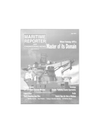
Committees, Associations, and Societies
Last Fall I had the opportunity to attend the Southeast Conference in Craig, Alaska. This conference is an association of communities working together on common issues such as transportation, their regional economy, and outside influences on their region such as the federal government. It is a great group of people, brought together by a common purpose: improving the quality of life for their communities.
Seeing this group effort made me reflect on other gatherings where people come together to work on common problems.
The marine industry is diverse geographically, economically, and politically.
It has been characterized historically by individuals of strong character, capable of making life or death decisions as they ply their livelihoods on the great and small waters. This is not a group to meekly follow a leader or to do something just because the other person is doing it. Getting a consensus opinion out of mariners is akin to herding cats — a challenge at best and a hopeless frustration at worst.
However the marine industry can and does work together. These are smart folks and they know that a collective voice is necessary if they are to defend and support their livelihoods. As a political consultant once said to a group of passenger vessel operators — "You are either a player or a victim". The message is clear: If you don't get involved and work with others towards common goals then you better be prepared to get rolled over.
Two great examples of the benefits of working together are the Passenger Vessel Association (PVA) and the American Waterways Operators (AWO).
When the U.S. Coast Guard was undertaking a major re-write of the Code of Federal Regulations affecting small passenger vessels, PVA pulled together operators and designers to review the proposed rules. Through a series of meetings, they crafted a detailed report which endorsed the positive features of the new rules and provided solid objections to those rules which were unnecessary or poorly crafted. The Coast Guard recognized the quality effort that went into the PVA response and listened carefully to PVA's opinions. As a result, the Subchapter T and Subchapter K rules that we are using today are workable and accepted by industry.
Similarly, when barges pushed by the tug MAUVILLA collided with an Amtrak railroad bridge causing the collapse of the bridge and the subsequent loss of life when a passenger train plunged into the water, the towing industry was confronted with calls for new regulations and strict oversight. The members of AWO could have hunkered down and fought blindly fought any proposed regulations. Alternatively, they could have rolled over and accepted whatever reactionary rules were placed upon them. Instead AWO worked with its member companies to create consensus standards for improved operation and management of the towing industry.
Further, these industry standards were made mandatory upon AWO members, a bold step that cost AWO some membership but showed the seriousness of AWO's commitment to improving their industry. The resulting Responsible Carrier Program is a model for other marine organizations to consider.
The message in all this is that we need to work together. I encourage everyone in the marine industry to get actively involved. Whether you drive a tug. design cruise ships, operate a platform supply vessel, or manage a fleet of tankers, there are organizations that are working for your benefit that could use your input. Seek out the trade associations such as AWO and PVA, get involved with committees such as the Merchant Marine Personnel Advisory Committee, or the American Bureau of Shipping Small Vessel Advisory Committee, join a professional association such as the Society of Naval Architects and Marine Engineers or the Council of Master Mariners. One of the great things about our country is the freedom to associate with other people and to speak with a collective voice. Small groups of dedicate individuals can accomplish amazing things.
So get involved! I guarantee that you will meet new people, learn more about your industry, and have an opportunity to make a difference.
Other stories from April 2003 issue
Content
- Doherty takes the Helm at Maritrans page: 8
- Electronic Milestone for Two-Stroke Champ page: 10
- Investment in Design page: 14
- New Era of the Double-Hull Bulker page: 14
- IZAR Sestao Launches 11,300-cu. m. Dredger page: 16
- Advance Notices of Arrival page: 19
- Government Update page: 20
- LCS Program Team Announced page: 23
- There's Something About Mary page: 24
- A Love of the Sea Takes Dreams to Reality page: 29
- Marlink Extends Radisson Seven Seas Contract page: 32
- CF ' 0 3 Spotlights Industry Challenges page: 32
- Azipull Technology Debuts on Offshore Vessels page: 33
- Keppel To Build $105M Jack-Up Bigfoot for ENSCO page: 34
- World Offshore Drilling Activity: A 5-Year Outlook page: 36
- Ulstein Delivers 23,500-hp Normand Master page: 40
- Offshore-Inland Provides the Fix page: 42
- Rolls-Royce Debuts New UT Designs page: 44
- DPS: Expanding Options for Many Operators page: 45
- Bollinger Delivers For K-Sea Transportation page: 47
- All the Men in the Sea page: 47
- VT Halmatic Takes Charge page: 49
- VT To Unveil Shipyard Technology Investment page: 51
- Speeding to Safety page: 52
- Scotland Sees Opportunity, Innovation in the North Sea page: 54
- ISPS Model Security Training Courses Update page: 57
- Committees, Associations, and Societies page: 61
- World Maritime Tech Exhibit Set For San Francisco page: 63
- SeaArk Delivers Patrol Boat to NYPD page: 64
- Camarc, Kvichak Team On Pilot Boat page: 65

